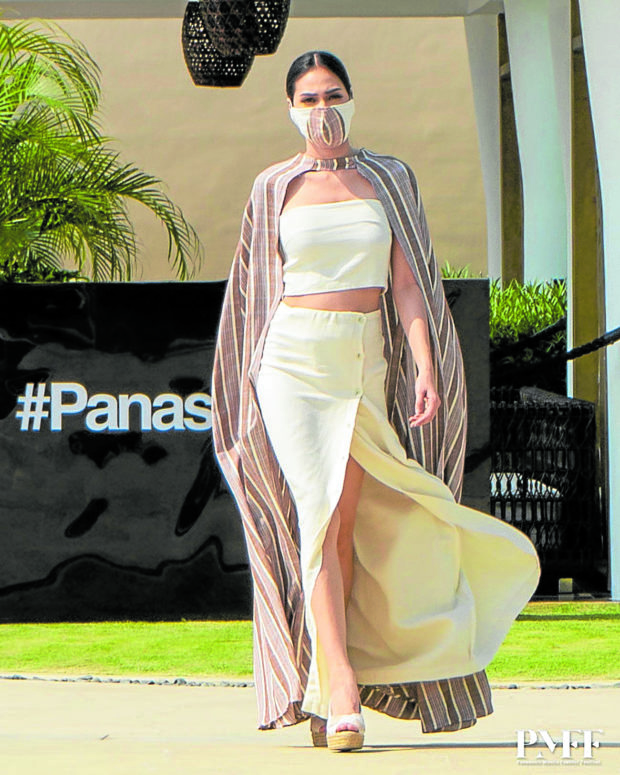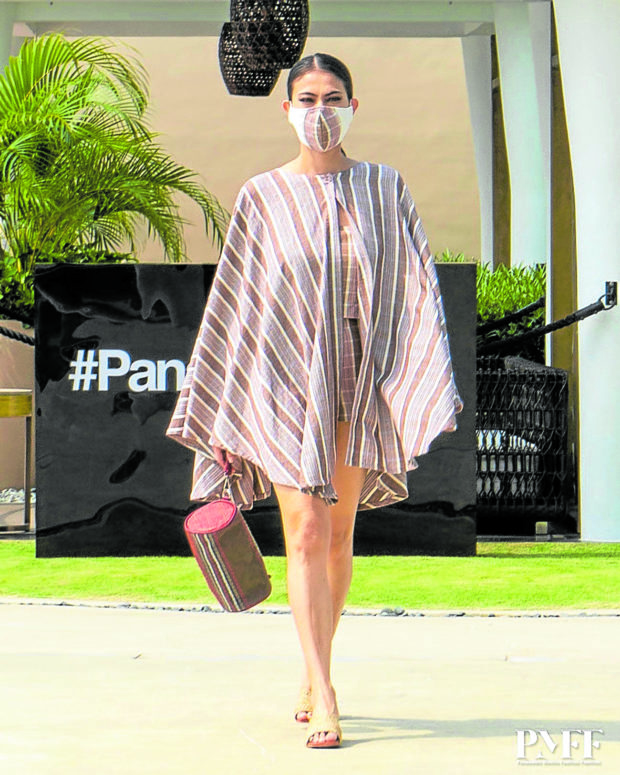
Camille Villanueva and Luis Espiritu’s business partnership happened almost by accident. They met at a meditation group during the lockdown last year. Her workers needed a job. He had spare fabrics.
Villanueva, like many fashion designers, had to close shop when the pandemic hit, leaving her cutters and seamstresses without work. Her master cutter was also sick with stage 4 cancer and needed money for her medications.
Espiritu, a veteran collaborator and creative director of various fashion and lifestyle brands, suggested she make face masks. That’s what she did, using excess cotton fabrics in her atelier. The first batch quickly sold out among friends. She had to make more.
Espiritu provided handwoven fabrics from his involvement with the GREAT (Gender Responsive Economic Actions for the Transformation) Women project, an advocacy group that supports various weaving communities and microentrepreneurs.

Slow fashion
Camlu, a combination of the first syllable of their names (@camlu1111 on Instagram), was born with the vision of creating “slow fashion,” one that’s not only a nod to the artisanal handwoven fabrics they vowed to use exclusively, but also to produce only when there’s an order, to avoid wastage and excess inventory.
“So, we make a prototype of a design, post it and if there’s an order, that’s the only time we produce,” Espiritu explained.
Villanueva, who made special-occasion, made-to-order dresses prepandemic, copped to the steep learning curve. She wasn’t used to doing business this way.
“People aren’t buying as much as before,” she noted. “After the most recent lockdown, we had zero orders, even worse than last year. We had to assess if this was sustainable. There’s much anxiety, from my workers down to everyone in general.” (In January, her cutter succumbed to her illness.)
cotton at the back—featuring Spanish fan-inspired sleeves and pleated neckline detail
But they hunkered down.
Their first full collection of luxe resort loungewear, using an innovative combination of pineapple fiber and cotton by the Negros-based social enterprise Creative Definitions, debuted at the recent Manila Fashion Festival.
The aim is to create contemporary Filipino designs with a universal appeal, said Espiritu. Thus, the sleeves of their
midriff-baring tops are inspired by either the maria clara or the pamaypay (Spanish fan). They also have short-shorts and bandeaus to appeal to a younger market.
The surprise hit, however, was their capes, both short and full-length, with orders received even from abroad.
(Orders can be made via their Instagram, and clothes take about two to three days to make. Separates start at P3,500. The shoes take five to six days.)
They’ve also partnered with shoemakers in Liliw, Laguna, to make everyday abaca sandals, slides (or “step-in,” in local parlance), and high-heeled wedges featuring handwoven fabrics.
“We’re effectively bringing communities together to create this sustainability chain,” Espiritu said.
Raising standards
There’s an obvious demand for slow fashion, as consumers become more aware of the devastating effects of fast fashion on the environment. But with so many entities and new brands riding on the handwoven fabric bandwagon, would this not dilute the headway achieved by advocates of artisanal Filipino fabrics?
“As long as there is imagination and creativity, I don’t think that’s an issue,” said Espiritu. If more people support the cause of elevating local fabrics, “They get better and better and the standard is raised.”
He gave the inabel as an example. With the revived interest in the Ilocos fabric in recent years, “inabel is saved,” he noted. “The tradition, the culture is not going to die because inabel has reached a mass and commercial appeal. It has also evolved, which is the goal for other textiles. Its uses have multiplied into this landscape full of ideas—from bed covers to table linens and now to fashion.”
He acknowledged that because of its artisanal and handmade nature, local fabrics are not cheap. “It used to have a niche market because of the price, but now it’s broken down into submarkets. It’s all over social media. We create and create to make it affordable.”
Because of the demand, local fabrics have also benefited from innovations. Many weaves have evolved to be suitable for clothing—“hindi na mainit,” Villanueva noted—and new color combinations have even emerged from indigenous weaves.
“Of course, these took many years to achieve,” Espiritu noted. And even then, continuous education is needed, to avoid being accused of cultural appropriation and misuse of these cultural treasures.
“For instance, I learned through GREAT Women that the Marawi textiles cannot be used for shoes because the weaves are believed to be made by the hands of God, thus stepping on it would be stepping on God’s work,” he added. “There’s a process of learning, so we progress in the right way.”
The big picture is to contribute to a better Filipino fashion industry, they both said. But ultimately, “It’s about people’s lives, about people dependent on us. So we work as a team to continue this interest,” Espiritu said.

